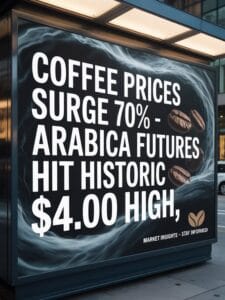Though coffee prices have crashed to five-month lows, they’re still 51% higher than last June, leaving companies like Tata Consumer Goods caught in the turbulence. Arabica futures fell to $3.35 a pound on June 17 amid improved coffee supply prospects, thanks to recent rains in Brazil easing drought fears. The USDA predicts global production will rise by 4% this season to nearly 175 million bags, but price volatility persists as markets adjust. For firms reliant on coffee beans, swings like these can squeeze profits or force sudden price hikes. In fact, understanding caffeine limits can help consumers make informed decisions amidst fluctuating prices. Moreover, the coffee-growing regions often face challenges related to climate change that impact supply stability.
Global coffee output is slowly recovering, with 2025/26 production expected to hit 171 million bags. Rabobank anticipates market rebalancing, with global coffee stocks swinging from a 900,000-bag deficit in 2024/25 to a 1.4-million-bag surplus by 2025/26. Brazil’s crop looks healthier for the 2026/27 season, while Colombia’s Arabica production should rebound by 2026. Vietnam and Brazil, key players in Robusta and Arabica, respectively, also anticipate stronger harvests. Industry analysts, including illycaffè’s CEO, forecast price stabilization at $2–$2.50/lb within 15 months as supply chains normalize.
Global coffee production recovers to 171M bags by 2025/26; Brazil’s Arabica and Vietnam’s Robusta crops strengthen as Colombia rebounds by 2026.
But lingering effects from 2021-22 shortages mean global supplies remain below 2020-21 levels, keeping markets jittery. Demand, however, is cooling. Global consumption is set to drop 0.5% in 2025, with Brazil and Germany cutting back amid high prices. Net imports fell 7% last quarter, pressuring prices further.
Even as wholesale costs dip, consumers still face pricier coffee on shelves—companies raised retail prices to cover earlier spikes. This mismatch between falling demand and rising supply hints at a market shift from shortage to surplus.
Prices could swing harder. Forecasts suggest Arabica may climb 20% in 2025 before dropping 11% in 2026. Robusta might jump 25% this year, then slide 9% next. Unpredictable weather, like droughts in Brazil, adds risk. Meanwhile, changes to how futures contracts are priced—switching from cents per pound to dollars per ton—could reshape trading strategies.
For Tata Consumer, heavy reliance on coffee as a raw material leaves it exposed. Wild price moves directly hit its input costs, squeezing margins. Though the firm passed higher costs to shoppers this year, that backfired as demand softened.
Now, with prices tumbling, it faces uncertainty: lock in lower rates now or bet on further declines. Either way, volatile commodities keep its balance sheet on shaky ground—a reality the coffee crunch laid bare.





